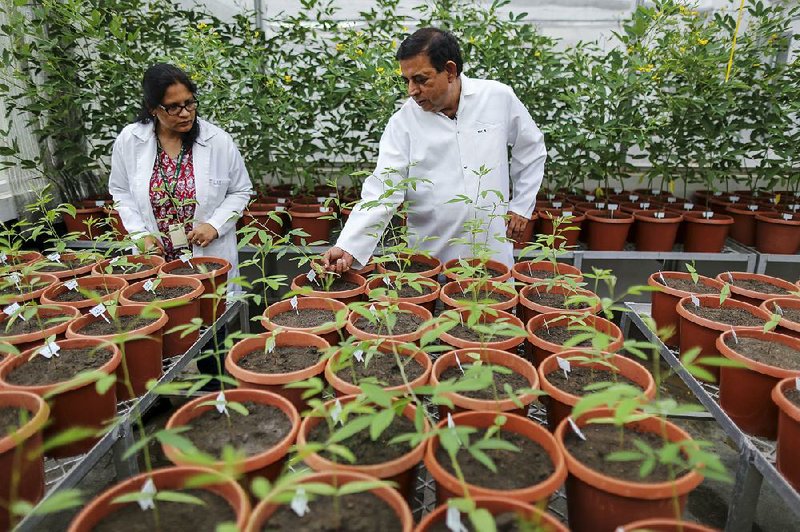On a campus in southern India, Kiran Sharma and his team of biologists are perfecting a recipe that they hope will solve the nation's inflation woes.
Sharma for six years has been testing a new variety of pigeon pea, a 3,000-year-old indigenous crop used to make dal, a staple of the diet in India. By adding a gene to the seed's DNA, he hopes to make it pest-proof, boost output by 30 percent and help reduce dependence on imports in a country that's both the world's biggest producer and consumer of dry legumes, also known as pulses.
"Insects are one major problem -- if you want to increase the productivity of the pigeon pea, then genetic engineering is the only way of doing it," said Sharma, who for more than 20 years has worked for the International Crops Research Institute for the Semi-Arid Tropics, a nonprofit organization known as Icrisat. After initial trials in a lab and a greenhouse, "we have some material we're reasonably satisfied with."
Widespread use of the revamped pigeon pea -- known locally as tur dal -- has the potential to boost yields that are less than half of China's, and could help the country reach its longer-term inflation target of 4 percent, lowering borrowing costs. Yet the new pea could take years to get to market. Many states in India oppose genetically modified crops and won't allow field trials.
"This is caught between different groups," said Devendra Kumar Pant, chief economist at India Ratings and Research Pvt., which is based in Mumbai (formerly known as Bombay). "The need right now is to increase productivity. How it will go up, that is for the government to decide."
Pulses are a key driver of Asia's second-highest inflation rate. Prices of the beans, chickpeas and lentils as a group have risen between 20 percent and 40 percent each month for the past year.
Prime Minister Narendra Modi has taken short-term steps to stem the price gains, including allocating more budget funds for farmers and boosting imports from neighboring Myanmar (formerly Burma). Last week, the government said it had released 21,000 metric tons from a newly created buffer stock. In the longer run, the key is to become more efficient.
Except for a few African countries, India's yield for pulses is among the lowest in the world. The country produces 1,442 pounds per 2.5 acres, compared with 3,417 pounds in China and 8,053 pounds in France, according to data compiled by the Indian Institute of Pulses Research.
Part of the reason is that India's pulses production is mostly dependent on rains, as farmers keep irrigated land for higher-paying crops such as wheat and rice. Pests are also a major culprit. Losses for the pigeon pea can be anywhere from 30 percent to 100 percent depending on the year, Sharma said.
In April, India's central bank called for the focus of agricultural research "to shift urgently to pulses with emphasis on developing short-duration pest- and disease-resistant varieties, seed multiplication and measures to increase crop yields so as to start off India's second green revolution."
The first revolution refers to about a decade in the 1960s and '70s, when India modernized agricultural practices-- including the use of pesticides and fertilizers -- to boost crop yields.
While groups including Icrisat and Assam Agricultural University, which is developing a genetically modified chickpea, get some public funding, they have still run into challenges from authorities.
Modi has yet to take a stance on genetically modified food, which remains controversial, particularly among members of his Hindu nationalist, vegetarian base. Farmers and activists saying that the technology carries risks for the environment and human health helped to persuade the previous federal government to declare a moratorium in 2010 on transgenic eggplants.
Even so, Modi's administration did say in May it was considering recommendations from a group of bureaucrats to speed up trials of genetically modified crops.
Niti Aayog, a government advisory body, in December published a report recommending exploring the technology for oilseeds and pulses. Requests to the Environment Ministry for comments on trials and the government's stance on biocrops were acknowledged but not answered.
At the level of India's 29 states, things can be yet more complicated.
Sharma at Icrisat has waited three years for state-level authorizations to test his pigeon peas in a confined field, the next stage in the process. While he has a permit from the central government, he hasn't received approval from authorities in Telangana, the state where the field trials would take place. Pocharam Srinivas Reddy, Telangana's agriculture minister, didn't respond to multiple requests for comment.
Sungro Seeds Pvt., a New Delhi-based company that won the license for Assam Agricultural University' genetically modified chickpea, got the greenlight from just one state for field trials, out of the 11 where it applied. The pest-resistant chickpea could increase output by at least up to 25 percent, according to the company.
"This additional requirement has become a major hurdle in the regulatory evaluation process of Biotech crops in the recent years, with no defined process being available with the state governments" for the certificate, Sungro said in an email, referring to state-level approval.
Back at Icrisat, Sharma and his team have other, somewhat more futuristic projects to keep them busy. That includes fortifying peanuts with vitamin A, which many people lack in the country.
"GM technology is here to stay -- sooner or later it will be routine," he said. "I don't think a good technology can be stopped."
Information for this article was contributed by Pratik Parija, Sharang Limaye and Archana Chaudhary of Bloomberg News.
SundayMonday Business on 07/24/2016
